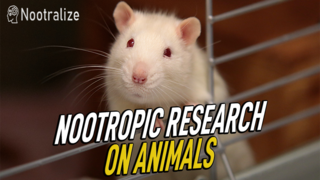Nootropics
How Useful is Animal Research on Nootropics for You?
On the limitations and usefulness of findings from animal studies on nootropics.
Posted August 24, 2020 Reviewed by Kaja Perina

Extrapolation of findings in animal studies on the effects of nootropics to possible effects in humans has several limitations.
Humans are different than other animals. There’s a difference in how people respond to nootropics compared with how other animals respond to nootropics. The difference in the effects of a substance between species is called the inter-species variation in drug response. This uncertainty factor is often used when attempting to determine the safety of a substance through animal experiments. For example, it is common to simply divide the dose with no observed adverse effects in animals with ten. The reason this is done is that it is plausible that there is a 10x difference between species in how much of a substance the average individual of a species can use and not get more than the same adverse effects as the average individual of another species.
With this sometimes large difference between species in how animals respond to different substances in mind, let’s explore how useful animal findings actually are for you as a nootropics enthusiast and self-experimenter.
Are animal findings useful for predicting the effects a substance will have on humans?
Several systematic reviews have shown that the usefulness of animal findings for predicting the effects a substance will have on humans is low.
“Seven additional reviews failed to demonstrate utility in reliably predicting human toxicological outcomes such as carcinogenicity and teratogenicity. Results in animal models were frequently equivocal, or inconsistent with human outcomes.” [1]
“We conclude that even if legitimate criticisms of animal models were addressed, through standardization of protocols and systematic reviews, the animal model would still fail as a predictive modality for human response to drugs and disease.” [2]
If proven safety or efficacy in animals doesn’t transfer to proven safety or efficacy in humans, why do scientists continue to conduct animal experiments?
How can we let animals suffer and die for findings that apparently have no application to human health?
We shouldn’t and we don’t, at least not as much anymore.
Animal research is moving into a new era with a more stringent and sympathetic methodology as a requirement for any study that researchers may carry out.
Research on how to keep animals safe, well, and with minimal suffering is being conducted continuously. [3]
Every animal study on the effects of a nootropic has to meet certain ethical criteria before the scientists start experimenting (unless they want to destroy their own reputation and options to get published in a journal).
When are animal studies useful?
While seemingly useless in the above-quoted systematic reviews, there are several reasons to conduct animal experiments on the effects of nootropics.
For one, animal studies are often extremely controlled. This is both a pro and a con. The primary negative aspect of it is that it doesn’t reflect the environment in which humans think and behave. The primary positive aspect of it is that the effects of the nootropic intervention can be isolated with a low risk of biased results.
Animal models have been useful historically in certain contexts, such as in the fields of psychology and nutrition. For example, “Pavlov’s dogs” is a very well known experiment that laid the groundwork for a whole new era in the field of psychology. In nutrition research, animal models have been useful for understanding interactions between nutrients as well as the ease of absorption of both macro- and micronutrients. [4]
It appears to be the case that a lot of animal research historically has been poorly done, with significant methodological flaws. However, it also appears to be the case that we’re moving away from bad science in animal research.
It’s all about the quality of the research. And this quality is extremely hard to gauge as a consumer. How are you supposed to know if a finding from an animal study on a nootropic is useful? The variation in animal species, study designs, outcome measures, and duration of the animal studies are all reasons why it’s almost impossible to transfer effects found in animal studies to likely effects in humans. [5] Researchers have a hard time doing this, so it’s no wonder if you get confused as a consumer looking to understand the science of a nootropic.
How do findings from animal studies compare with placebo-controlled studies or self-experiments?
They don’t. Self-experiments and other experiments on the effects of a nootropic in healthy humans are generally in another league as regards the usefulness of the evidence for predicting future outcomes (in healthy humans).
Placebo-controlled studies and well-designed self-experiments are much more useful for determining the effects a nootropic will have for you than any animal study would likely ever be.
The complexity (sometimes impossibility) of transferring results found in animals to humans, is probably the most significant reason behind why you shouldn’t trust findings from animal studies when making decisions about your nootropic use.
This blog post was originally published at blog.nootralize.com, it is not a substitute for professional medical advice, diagnosis, or treatment.




